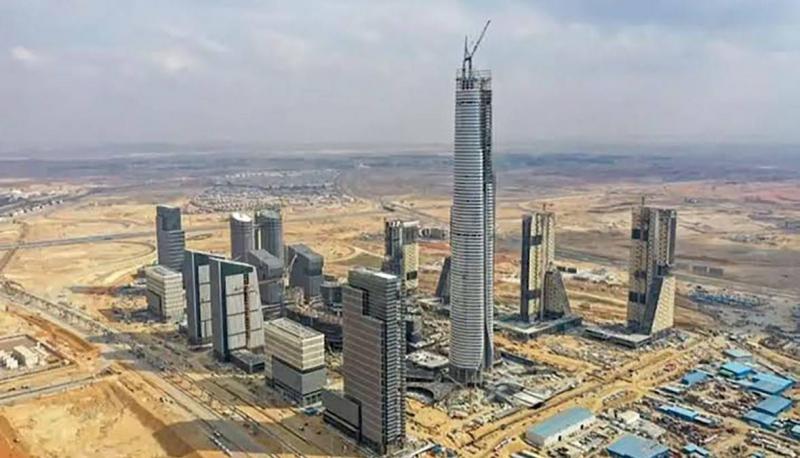With the inauguration of Egyptian President Abdel Fattah El-Sisi for a third term on Tuesday at the new administrative capital's parliament, discussions have intensified regarding the fate of Cairo, Egypt's historical capital. Founded during the Fatimid era in 969 AD, many Egyptians fear the decline of this historic city and its potential neglect following the transfer of government offices to the new administrative capital, located 60 kilometers from Cairo. Conversely, some argue this concern is unfounded since the new administrative capital administratively falls under Cairo Governorate, and the relocation of government institutions does not pose a threat to the old capital.
Questions have arisen regarding the fate of the buildings that the government will vacate, particularly the heritage sites. Amidst all this, a proposed law has emerged in the Egyptian parliament that aims to convert the administrative capital into a state that administratively belongs to Cairo Governorate.
The Proposal
Dr. Mohamed Attia El-Fayoumi, head of the Housing Committee in the Egyptian parliament, told "Al-Nahar Al-Arabi" that "the new administrative capital has become part of the urban area of Cairo Governorate following its recent expansion to ensure that the relocation of government institutions does not violate the Egyptian constitution." Article 114 of the Egyptian constitution stipulates that "the location of the House of Representatives is in the city of Cairo, and it may, in exceptional circumstances, hold its sessions elsewhere upon the request of the President of the Republic or one-third of the council members; any meeting of the council held in violation of this is void." It should be noted that the Egyptian Cabinet, led by Mostafa Madbouly, approved a presidential decree in June 2022 to modify the eastern border of Cairo Governorate to include the new administrative capital's land areas, in compliance with the constitutional text.
Despite overcoming the constitutional hurdle, El-Fayoumi points out that there are administrative and organizational challenges facing the new administrative capital in its current form. Being part of Cairo's districts hinders its administrative function; thus, to manage it properly, the new city must be divided into smaller administrative units comprising various neighborhoods. This is particularly important considering its vast area of about 700 square kilometers, or 170,000 acres, which is larger than Singapore. To address this issue, El-Fayoumi prepared a new local administration law that grants the administrative capital the status of a "state," which is an administrative unit smaller than a governorate but larger than a district, allowing for its division into neighborhoods while ultimately remaining under Cairo Governorate.
El-Fayoumi adds that he proposed the new local administration law eight years ago during the previous parliamentary session, but it has yet to see the light. The proposed bill currently resides in the local administration committee of the parliament, awaiting discussion. Within this proposed law, El-Fayoumi has dedicated a separate section for Cairo Governorate, which includes establishing a Special Board of Trustees for the new administrative capital, granting it extensive powers similar to local councils in other governorates. This section also provides special powers to the Governor of Cairo, enabling him to manage the complexities of the capital, which encompasses all government institutions.
El-Fayoumi, also a local administration expert in Egypt, emphasizes that this proposal is not unprecedented, as many local governance systems around the world operate similarly. He concludes that the successful implementation of this proposal through parliamentary approval of the bill hinges on the political will in the country.
Utilization of Old Buildings
Questions persist about the fate of government offices after the official transition to the new administrative capital. The evacuation of these buildings leaves behind significant architectural wealth awaiting re-utilization, according to Dr. Soheir Hawwas, a member of the National Coordinating Body for Urban Planning and a professor of architecture and urban design at Cairo University.
Hawwas expresses her concern to "Al-Nahar Al-Arabi" about the decline in government attention to Cairo and the concentration of efforts on the new administrative capital, even if the latter remains under Cairo Governorate. She calls for the establishment of an independent authority to manage and protect historical Cairo from neglect. Regarding the ways to repurpose government offices, Soheir Hawwas emphasizes the importance of relying on experts skilled in re-utilizing these buildings, stating, "Those who construct new buildings may lack experience in restoring and repurposing heritage buildings."
The Egyptian academic explains that the buildings awaiting re-utilization fall into two categories: the first category includes government buildings with service-oriented designs, characterized by similar rooms and featuring parking lots, like the Tahrir Complex. This type of building is suitable for conversion into hotels or hospitals. The second category consists of heritage buildings, which require what is called compatible reuse; each building has its own uniqueness and necessitates independent study to achieve the goals of restoration and repurposing.
She points out that "heritage buildings are more compatible with cultural activities than others, as they are less likely to be damaged," recalling the conversion of some historical palaces into schools and the subsequent harm that resulted from this procedure.
Massive Investments
Around 34 government offices, including all ministries and official institutions except for Al-Azhar, are moving to the new administrative capital. A study conducted by the Capital Center for Economic Studies and Research estimated that the value of the old government buildings exceeds 700 billion Egyptian pounds (8.14 billion USD).
The government offices in Cairo are classified into three categories: the first is not registered as a monument with the Ministry of Antiquities and does not belong to a unique architectural style. The second is historical with a distinctive architectural style and registered with the Urban Coordination Fund. The third category consists of archaeological offices under the Ministry of Tourism and Antiquities.
These buildings are owned by three entities: the Sovereign Fund of Egypt, which receives ownership of the unused government buildings, the Egypt Real Estate Asset Management Company, which is an Egyptian joint-stock company affiliated with the Egypt Holding Company for Insurance, and the Ministry of Tourism and Antiquities, which owns and protects buildings registered as monuments.
Recently, the government announced a series of investment deals and re-utilization plans for the evacuated government buildings, including the Tahrir Complex (1951), which was the first government service complex in Egypt. Earlier in 2023, it was announced that its name would change to "Cairo House," transforming it into a luxury hotel and mixed-use complex with investments reaching 200 million USD, expected to open by the end of 2025.
The Ministry of Interior building is also undergoing a development plan to transform it into a specialized area for innovation and entrepreneurship, featuring commercial stores, administrative offices, a branch of France's IPAG Business School, a global outsourcing services center, and a three-star hotel. Other high-value buildings in Cairo include the House of Representatives, comprised of three buildings constructed over time, with the oldest dating back to 1881, and the Ministry of Education building, established by Khedive Ismail in 1874. The Ministry of Awqaf building was built in 1899 in Mamluk style.
Renewing History
Cairo, as we know it today, has witnessed various cities and government offices throughout its history, all within the geographical boundaries of Cairo Governorate, starting from Al-Fustat, to Al-Askar and Al-Qata'i, followed by Fatimid Cairo, up to the Citadel, and finally to Khedive Cairo. Researcher in the history of Cairo and author of "Al-Fustat and Its Gates," Abdul Rahman Al-Tawil recalls the stages of Cairo's formation, stating that "the city has always expanded in the form of ruling suburbs. Initially, these suburbs were restricted to the rulers or government apparatus, with walls enclosing them or an elite few having the right to reside within these areas."
He adds to "Al-Nahar Al-Arabi": "With urban expansion and changes in governments, ruling suburbs would transform into ordinary residential neighborhoods, prompting the search for new ruling suburbs, typically to the northeast. This can be seen in Al-Fustat, which transitioned from ruling neighborhood to a residential area, just as the same occurred with the creation of Al-Askar city, which was the seat of the Abbasid governor, and then governance moved during the reign of Ahmad ibn Tulun to Al-Qata'i, which resembled a princely neighborhood and later became part of the city."
With the emergence of Fatimid Cairo within its walls, it served as a royal city inhabited by the caliph, his court, and state employees, with the government offices located there. The Ayyubid state later opened the city to the common people, turning it into one of the larger neighborhoods of the city, prompting the Ayyubids to search for a new seat of power, which became the Citadel.
Governance in Egypt continued from the Citadel starting in 1184 AD during the rule of Al-Kamil ibn Salah al-Din Ayyubi, through the Mamluk and Ottoman eras, until the reign of Khedive Ismail, when the seat of governance was moved from the Citadel to Abdeen Palace in the late 19th century.
The historian of Cairo traces the transformations the city has undergone in modern times, noting that Khedive Cairo was initially a neighborhood for the elite, inhabited by classes close to power and foreigners, along with governmental offices present within its boundaries.
Al-Tawil mentions that growth began to shift toward the northeast, to Nasr City and Heliopolis, observing the relocation of many ministries to these areas during the presidencies of the late Mohamed Anwar Sadat and Mohamed Hosni Mubarak, which is similar to what is currently happening with the new administrative capital.
The Egyptian researcher stresses that "the historical significance of Cairo cannot be rivaled by any new or old city within Egypt," pointing out that "Cairo enjoys historical, cultural, and bureaucratic weight accumulated over more than 1,400 years. This accumulation prevents the decline of the ancient city's significance; however, it sometimes shifts within Cairo. Ultimately, it can be said that the new administrative capital lies within Cairo's boundaries and is one of its suburbs."




